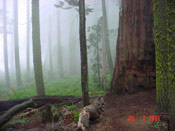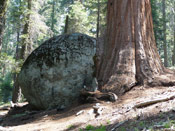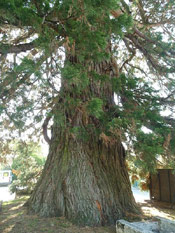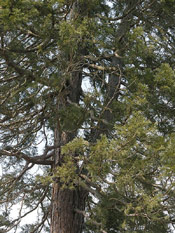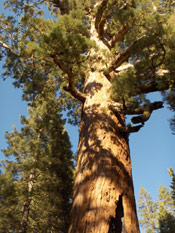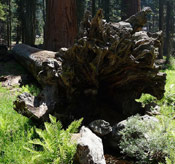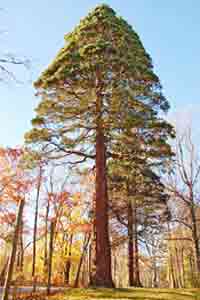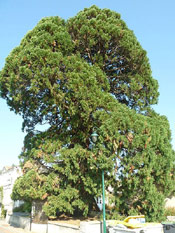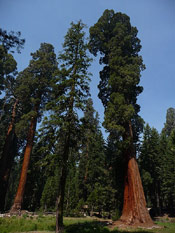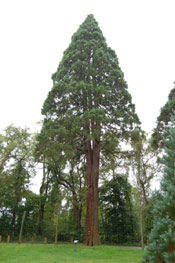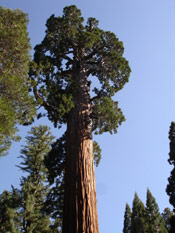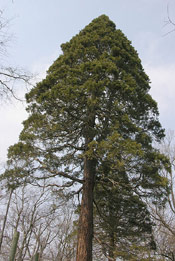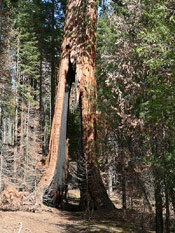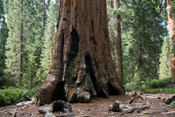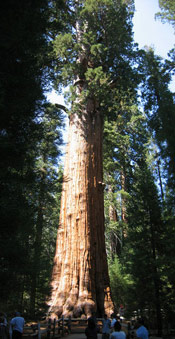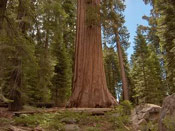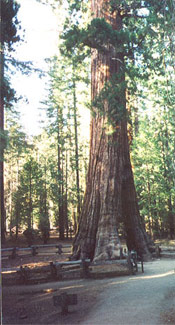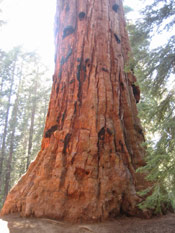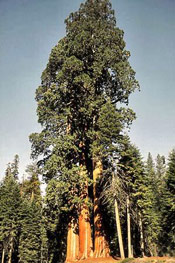E.A.R. To the Ground: Explorations of Agricultural Research
E.A.R. To The Ground is a project designed to connect global and local scales of agriculture.
Wednesday, May 2, 2012
The Sequoia Tree
Sequoiadendron giganteum (giant sequoia, Sierra redwood, Sierran redwood, or Wellingtonia) is the sole living species in the genus Sequoiadendron, and one of three species of coniferous trees known as redwoods, classified in the family Cupressaceae in the subfamily Sequoioideae, together with Sequoia sempervirens (Coast Redwood) and Metasequoia glyptostroboides (Dawn Redwood). The common use of the name "sequoia" generally refers to Sequoiadendron, which occurs naturally only in groves on the western slopes of the Sierra Nevada Mountains of California.
Giant Sequoias are the world's largest trees in terms of total volume (technically, only 7 living Giant Sequoia exceed the 42,500 cubic feet (1,200 m3) of the Lost Monarch Coast Redwood tree; see Largest trees). They grow to an average height of 50 to 85 metres (160 to 279 ft) and 6 to 8 metres (20 to 26 ft) in diameter. Record trees have been measured to be 94.8 metres (311 ft) in height and 17 metres (56 ft) in diameter. The oldest known Giant Sequoia based on ring count is 3,500 years old. Sequoia bark is fibrous, furrowed, and may be 90 centimetres (3.0 ft) thick at the base of the columnar trunk. It provides significant fire protection for the trees. The leaves are evergreen, awl-shaped, 3 to 6 mm long, and arranged spirally on the shoots. The seed cones are 4 to 7 cm long and mature in 18 to 20 months, though they typically remain green and closed for up to 20 years; each cone has 30 to 50 spirally arranged scales, with several seeds on each scale giving an average of 230 seeds per cone. The seed is dark brown, 4 to 5 mm long and 1 mm broad, with a 1 mm wide yellow-brown wing along each side. Some seed is shed when the cone scales shrink during hot weather in late summer, but most seeds are liberated when the cone dries from fire heat or is damaged by insects.
Giant sequoia cones.Giant sequoia regenerates by seed. Trees up to about 20 years old may produce stump sprouts subsequent to injury. Giant sequoia of all ages may sprout from the bole when old branches are lost to fire or breakage, but (unlike coast redwood) mature trees do not sprout from cut stumps. Young trees start to bear cones at the age of 12 years.
At any given time, a large tree may be expected to have approximately 11,000 cones. The upper part of the crown of any mature Giant Sequoia invariably produces a greater abundance of cones than its lower portions. A mature giant sequoia has been estimated to disperse from 300,000-400,000 seeds per year. The winged seeds may be carried up to 180 m (600 ft) from the parent tree.
Lower branches die fairly readily from shading, but trees less than 100 years old retain most of their dead branches. Trunks of mature trees in groves are generally free of branches to a height of 20 to 50 m, but solitary trees will retain low branches.
The natural distribution of giant sequoia is restricted to a limited area of the western Sierra Nevada, California. The giant sequoias are having difficulty reproducing in their original habitat (and very rarely reproduce in cultivation) due to the seeds only being able to grow successfully in mineral soils in full sunlight, free from competing vegetation. Although the seeds can germinate in moist needle humus in the spring, these seedlings will die as the duff dries in the summer. They therefore require periodic wildfire to clear competing vegetation and soil humus before successful regeneration can occur. Without fire, shade-loving species will crowd out young sequoia seedlings, and sequoia seeds will not germinate. When fully grown, these trees typically require large amounts of water and are therefore often concentrated near streams.
Fires also bring hot air high into the canopy via convection, which in turn dries and opens the cones. The subsequent release of large quantities of seeds coincides with the optimal post-fire seedbed conditions. Loose ground ash may also act as a cover to protect the fallen seeds from ultraviolet radiation damage.
Due to fire suppression efforts and livestock grazing during the early and mid 20th century, low-intensity fires no longer occurred naturally in many groves, and still do not occur in some groves today. The suppression of fires also led to ground fuel build-up and the dense growth of fire-sensitive White Fir. This increased the risk of more intense fires that can use the firs as ladders to threaten mature Giant Sequoia crowns. Natural fires may also be important in keeping carpenter ants in check.
The giant sequoia was well known to Native American tribes living in its area. Native American names for the species include Wawona, Toos-pung-ish and Hea-mi-withic, the latter two in the language of the Tule River Tribe.
Wood from mature giant sequoias is highly resistant to decay, but due to being fibrous and brittle, it is generally unsuitable for construction. From the 1880s through the 1920s logging took place in many groves in spite of marginal commercial returns. Due to their weight and brittleness trees would often shatter when they hit the ground, wasting much of the wood. Loggers attempted to cushion the impact by digging trenches and filling them with branches. Still, it is estimated that as little as 50 percent of the timber made it from groves to the mill. The wood was used mainly for shingles and fence posts, or even for matchsticks.
Giant Sequoia is a very popular ornamental tree in many areas. Areas where it is successfully grown include most of western and southern Europe, the Pacific Northwest of North America north to southwest British Columbia, the southern United States, southeast Australia, New Zealand and central-southern Chile. It is also grown, though less successfully, in parts of eastern North America.
Giant sequoias are grown successfully in the Pacific Northwest and southern US, and less successfully in eastern North America.
Immature seed (female) cones of cultivated tree in Portland, Oregon, USA (fall)Giant Sequoia cultivation is very successful in the Pacific Northwest from western Oregon north to southwest British Columbia, with fast growth rates. In Washington and Oregon, it is common to find giant sequoias that have been successfully planted in both urban and rural areas.
Report: Smoke from wildfires kills over 300,000 per year worldwide
Published February 20, 2012
The Wall Street Journal
Every year, accidental and deliberate wildfires burn an area that, taken together, is larger than India. The dense plumes of fine particles and compounds released in the complex chemistry of combustion typically stay aloft for weeks and can travel hundreds of miles downwind. Smoke from fires in Central Siberia during 2003, for example, caused air pollution in the US.
To estimate the public health consequences, scientists led by fire researcher Fay Johnston from the University of Tasmania in Hobart, Australia, studied the impact of the fine particulate matter released during such blazes between 1997 and 2006, using satellite data, computer models of wind patterns and mortality tables developed by the World Health Organization.
"I personally was surprised that the estimate of deaths was so high," said Johnston, who presented the findings at a symposium Sunday during a meeting of the American Association for the Advancement for Science (AAAS) in Vancouver. The findings were also published online in the journal Environmental Health Perspectives.
Southeast Asia and sub-Saharan Africa were hit hardest by the ill effects of smoke from wildfires and deliberate burning for clearing land, the research team said.
In Africa, about 157,000 people died annually as a consequence of smoke pollution, the scientists said. In Southeast Asia, 110,000 on average were killed every year by medical conditions related to inhalation of wildfire smoke.
By comparison, public health experts estimate that urban air pollution generally kills about 800,000 people every year, and the indoor fumes from household fuels cause about 1.6 million deaths annually.
The medical consequences of smoke from wildfires are likely to worsen in coming years, however, if predictions of long-term rising temperatures due to heat-trapping greenhouse gas emissions come true, researchers at the AAAS meeting said.
Hotter and drier summers to come will result in longer fire seasons and more intense wildfire fires that may be harder to control, they said.
Researchers have estimated that for each additional degree centigrade in global mean temperature, there could be more storms and a five percent increase in the amount of lightning, which can ignite dry forests and savannahs.

Tuesday, May 1, 2012
Subscribe to:
Comments (Atom)
